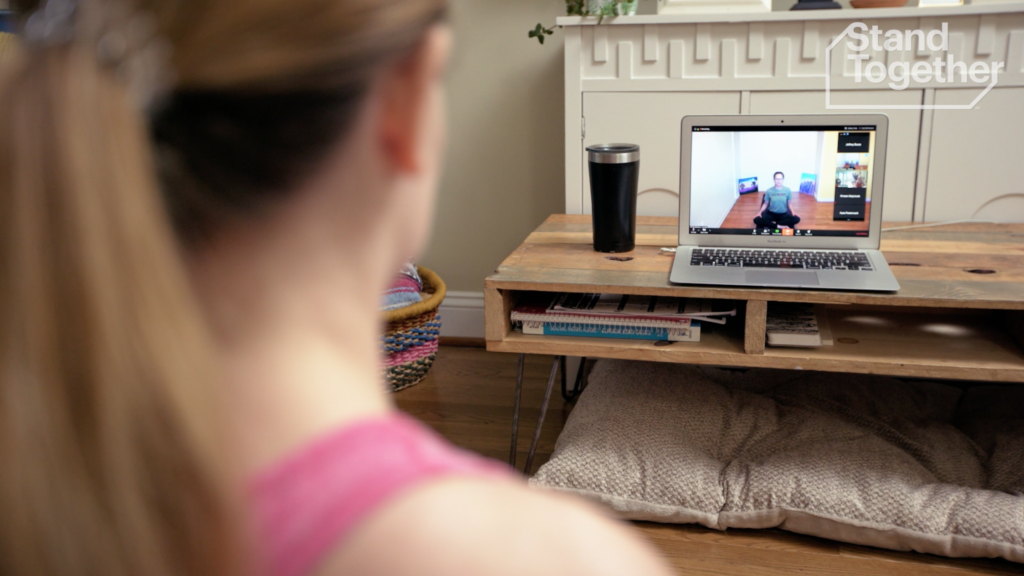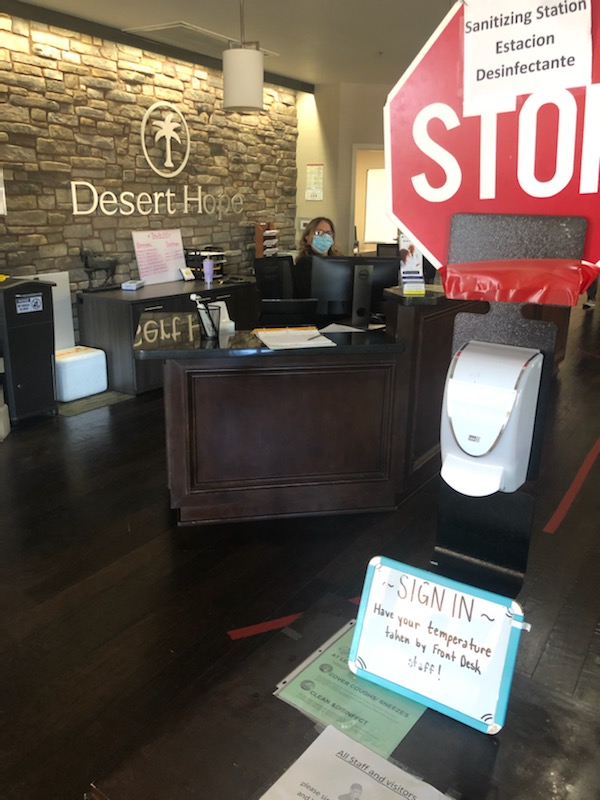Addressing addiction in a pandemic: What recovery resource providers have learned from months of lockdown

Retail alcohol sales in the U.S. jumped by 55 percent the third week of March, and, in May, overdose deaths increased by 42 percent, showing evidence of a “hidden epidemic” of substance abuse in the midst of the COVID-19 pandemic that organizations in Nevada are working hard to address, even with limited capacity to operate.
Nonprofits, recovery facilities and other organizations offering help to those suffering from substance abuse disorders have all had to find ways to provide the contact and support necessary for recovery while complying with stay at home orders and social distancing requirements. Although they are hoping for a return to normal in the near future, many have developed new strategies and programs that they plan to implement permanently.
“We prefer to call it physical distancing because, you know, we believe we can stay connected socially, even if you’re just going to the virtual space,” Scott Strode, founder of The Phoenix, a nonprofit that offers free weekly fitness classes and activities for individuals recovering from substance use disorders.
Prior to the COVID-19 pandemic, The Phoenix offered in-person classes in 24 states but as facilities were forced to close, the organization was able to quickly pivot to an online platform and now offers 50 live, virtual classes each week.
As some businesses have slowly re-opened, the organization has also resumed some outdoor activities such as hiking and outdoor yoga. But, according to Strode, even when in-person activities can fully resume, they plan to continue offering their new online programming.
“It’s been great because it’s allowed us to reach into more rural communities, places that historically we couldn’t have in person programs,” Strode said. “It’s allowed people to come to our programs who may have young children that historically couldn’t get child care to come to a Phoenix event.”

Strode also believes that online programming is more likely to draw in young people in need of help, who may be overwhelmed by the prospect of attending a physical meeting or event.
“There’s a young recovery community sort of coming up that’s digitally connected, that actually may feel a little less intimidated to come to a Phoenix event that’s virtual than to come in person,” Strode said.
He has seen individuals seeking online treatment as a result of lockdown, realizing that isolation, fewer work obligations, and unlimited time at home could cause their substance abuse problems to become far more problematic.
“We have a young woman who recognized that, going into this pandemic, there was a possibility that her drinking could actually get much worse,” Strode said. “And so, she decided to get sober during the pandemic and she came to a Phoenix class, and she just celebrated 30 days in recovery.”
Impacts of isolation
Many individuals may not be able to identify the impact that lockdown and stay at home orders will have on their substance issues in order to proactively address them. For Strode, being close, both emotionally and physically, with a community of peers was important to his recovery.
“We’re pretty hopeful and excited for the day that we can be around people and hug each other once again, fist bump at a workout and just have that community feel again,” Strode said.
Nielsen reports that online alcohol sales in the U.S. were up nearly 500 percent at the end of April. Overdose death rates rose 18 percent in March, 29 percent in April, and 55 percent in May compared to the same month in 2019. The country is consuming and abusing substances at a higher rate, and experts believe isolation is part of the cause.
“Even though it’s kind of ‘the new norm,’ this really isn’t normal,” Dona Dmitrovic, the executive director of the Foundation for Recovery in Southern Nevada said.
Dmitrovic’s organization has been able to slowly resume in-person services, opening offices for individuals to use computers and opening some meeting spaces at limited capacity. These are important steps for Dmitrovic who has observed that it is more difficult for people to begin their recovery journey with no physical counseling or meeting options.
“Attending meetings online I very, very rarely have seen somebody that was brand spanking new walk ins — not even walk in — to Zoom into a meeting,” she said.
A lot of the crisis or helplines that newcomers turn to when seeking help routinely direct people towards offices and physical locations and may not have the resources to know about every available Zoom meeting, according to Dmitrovic.
Still, Dmitrovic’s early apprehension about online meetings has eased after months of experience with the new method, and she even hopes to continue the online meetings they have been operating in partnership with other organizations around the country in order to allow individuals in recovery to make connections nationally.
“I think as time goes on, you get more comfortable, and I would say for people that have been in recovery for a little while it’s easier to connect,” Dmitrovic said.
In-patient treatment
Things are different in some in-patient recovery centers where hyper-vigilant sanitation and regular testing allows patients to remain in contact with each other, attending group sessions and counseling.

Desert Hope Treatment Center in Las Vegas shut down its facility to outside visitors in March and, since, has drastically enhanced their safety measures. In addition to mask requirements, temperature scanning, travel questionnaires, and extensive cleaning, every individual in the residential, in-patient treatment program is tested for the virus every two weeks.
American Addiction Centers, which operates the Desert Hope facility, announced in April that testing would take place at its locations for patients and staff.
Price finds that visual markers of safety, such as signage, masks and tape on the floors designating proper distancing, is effective in reassuring patients, many of whom suffer from co-occurring mental health issues, that they are safe.
“We want to make sure that our patients see, touch, taste and feel all the different safety measures,” he said.
In the first weeks of the pandemic, Price observed more patients seeking treatment and fewer patients leaving the facility against medical advice, something he suspected was caused by uncertainty about the safety of the world outside their closed medical center. However, this is not a trend that has continued as uncertainty has largely faded and many patients adjust to their new reality.
“We don't see a lot of fear and apprehension of the unknown when it comes to this pandemic from our patient population. Early on that wasn't the case because nobody knew,” he said. “But now, people are fairly educated; they've come to whatever their level of comfortability is.”

Although Price anticipates that measures such as screening and testing will be phased out when the pandemic no longer poses a threat, he believes that the increases in sanitation measures will become permanent practice.
“While it was uncomfortable, moving to the level of stringent, meticulous disinfecting, and being prepared for this pandemic, it’s become our normal, and I don’t believe that I’m going to lower the standards, even if the pandemic goes away,” he said. “Because I just believe that we’re at a higher level and a higher standardization of the ability to serve patients.”
Digital divide
Desert Hope also provides outpatient services and has increased its telehealth services for outpatients seeking treatment. However, telehealth and online services come with their own limitations.
“The economic impacts of substance use disorders are pretty profound,” Strode said. “I think that takes away a lot of the opportunities that people may have had before their addiction and can lead to folks experiencing homelessness and involvement in the criminal justice system.”
These people may not have access to a private computer from which they can access the free online resources provided by The Phoenix or the Foundation for Recovery, let alone pay for the telehealth services offered by Desert Hope. This digital divide can prevent individuals from seeking treatment.
While Foundation for Recovery has been able to open its facilities and allow individuals in need to use their computers, it is still difficult for many who do not have the means to pay for their own telephones or broadband services to access online resources.
For these people, the hope is that a reopening will be able to come sooner, rather than later, and that the meetings that are slowly resuming will return to normal, hugs and all.
“I would hope that we can, at some point, get back to making that personal connection,” said Dmitrovic. “But, you know, for now we’re just taking it day by day. Like recovery, right? One day at a time.”
